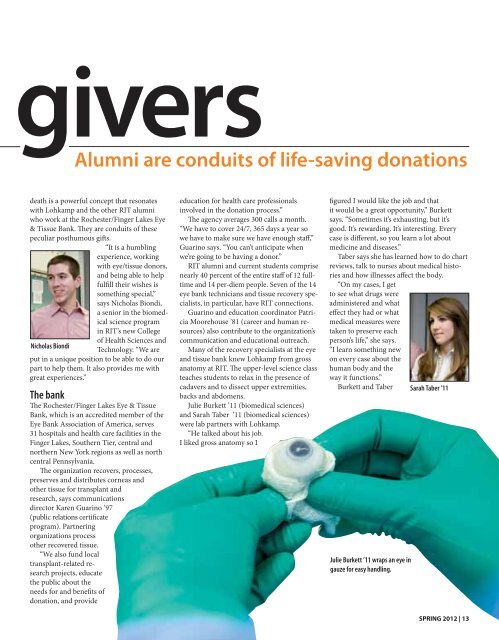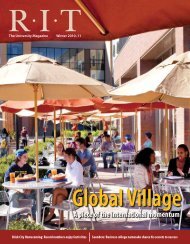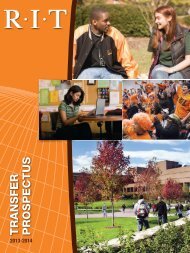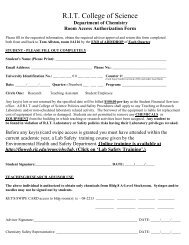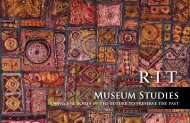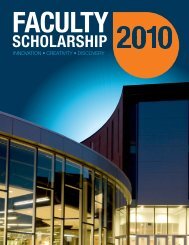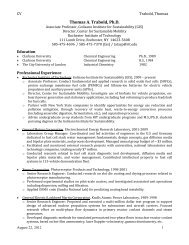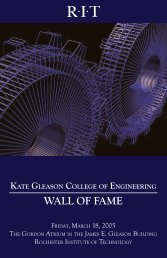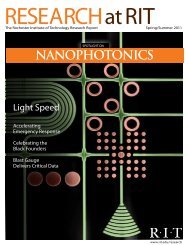Reading, writing and playing - Rochester Institute of Technology
Reading, writing and playing - Rochester Institute of Technology
Reading, writing and playing - Rochester Institute of Technology
You also want an ePaper? Increase the reach of your titles
YUMPU automatically turns print PDFs into web optimized ePapers that Google loves.
givers<br />
Alumni are conduits <strong>of</strong> life-saving donations<br />
death is a powerful concept that resonates<br />
with Lohkamp <strong>and</strong> the other RIT alumni<br />
who work at the <strong>Rochester</strong>/Finger Lakes Eye<br />
& Tissue Bank. They are conduits <strong>of</strong> these<br />
peculiar posthumous gifts.<br />
“It is a humbling<br />
experience, working<br />
with eye/tissue donors,<br />
<strong>and</strong> being able to help<br />
fulfill their wishes is<br />
something special,”<br />
says Nicholas Biondi,<br />
a senior in the biomedical<br />
science program<br />
in RIT’s new College<br />
Nicholas Biondi<br />
<strong>of</strong> Health Sciences <strong>and</strong><br />
<strong>Technology</strong>. “We are<br />
put in a unique position to be able to do our<br />
part to help them. It also provides me with<br />
great experiences.”<br />
The bank<br />
The <strong>Rochester</strong>/Finger Lakes Eye & Tissue<br />
Bank, which is an accredited member <strong>of</strong> the<br />
Eye Bank Association <strong>of</strong> America, serves<br />
31 hospitals <strong>and</strong> health care facilities in the<br />
Finger Lakes, Southern Tier, central <strong>and</strong><br />
northern New York regions as well as north<br />
central Pennsylvania.<br />
The organization recovers, processes,<br />
preserves <strong>and</strong> distributes corneas <strong>and</strong><br />
other tissue for transplant <strong>and</strong><br />
research, says communications<br />
director Karen Guarino ’97<br />
(public relations certificate<br />
program). Partnering<br />
organizations process<br />
other recovered tissue.<br />
“We also fund local<br />
transplant-related research<br />
projects, educate<br />
the public about the<br />
needs for <strong>and</strong> benefits <strong>of</strong><br />
donation, <strong>and</strong> provide<br />
education for health care pr<strong>of</strong>essionals<br />
involved in the donation process.”<br />
The agency averages 300 calls a month.<br />
“We have to cover 24/7, 365 days a year so<br />
we have to make sure we have enough staff,”<br />
Guarino says. “You can’t anticipate when<br />
we’re going to be having a donor.”<br />
RIT alumni <strong>and</strong> current students comprise<br />
nearly 40 percent <strong>of</strong> the entire staff <strong>of</strong> 12 fulltime<br />
<strong>and</strong> 14 per-diem people. Seven <strong>of</strong> the 14<br />
eye bank technicians <strong>and</strong> tissue recovery specialists,<br />
in particular, have RIT connections.<br />
Guarino <strong>and</strong> education coordinator Patricia<br />
Moorehouse ’81 (career <strong>and</strong> human resources)<br />
also contribute to the organization’s<br />
communication <strong>and</strong> educational outreach.<br />
Many <strong>of</strong> the recovery specialists at the eye<br />
<strong>and</strong> tissue bank knew Lohkamp from gross<br />
anatomy at RIT. The upper-level science class<br />
teaches students to relax in the presence <strong>of</strong><br />
cadavers <strong>and</strong> to dissect upper extremities,<br />
backs <strong>and</strong> abdomens.<br />
Julie Burkett ’11 (biomedical sciences)<br />
<strong>and</strong> Sarah Taber ’11 (biomedical sciences)<br />
were lab partners with Lohkamp.<br />
“He talked about his job.<br />
I liked gross anatomy so I<br />
figured I would like the job <strong>and</strong> that<br />
it would be a great opportunity,” Burkett<br />
says. “Sometimes it’s exhausting, but it’s<br />
good. It’s rewarding. It’s interesting. Every<br />
case is different, so you learn a lot about<br />
medicine <strong>and</strong> diseases.”<br />
Taber says she has learned how to do chart<br />
reviews, talk to nurses about medical histories<br />
<strong>and</strong> how illnesses affect the body.<br />
“On my cases, I get<br />
to see what drugs were<br />
administered <strong>and</strong> what<br />
effect they had or what<br />
medical measures were<br />
taken to preserve each<br />
person’s life,” she says.<br />
“I learn something new<br />
on every case about the<br />
human body <strong>and</strong> the<br />
way it functions.”<br />
Burkett <strong>and</strong> Taber Sarah Taber ’11<br />
Julie Burkett ’11 wraps an eye in<br />
gauze for easy h<strong>and</strong>ling.<br />
SPRING 2012 | 13


